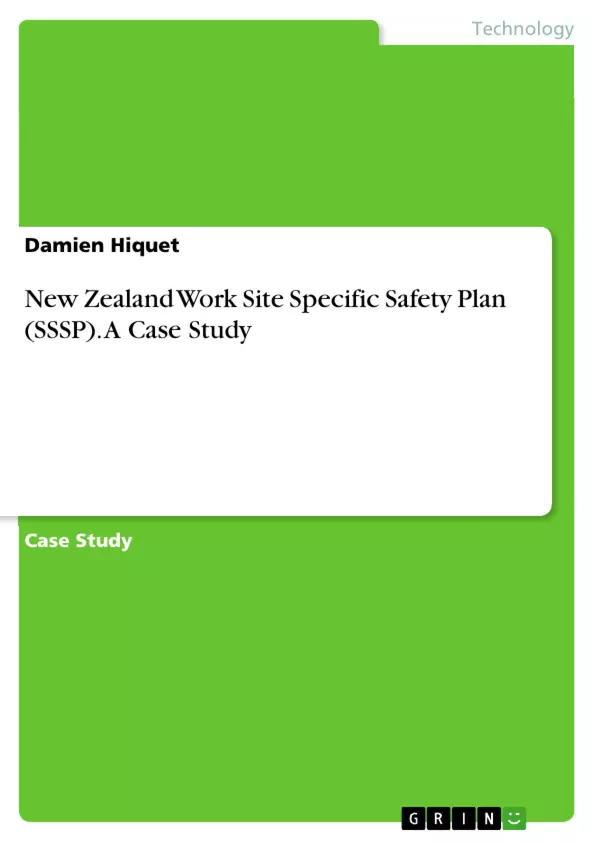This case study prepares an onsite Occupational Health and Safety Management System or Site Specific Safety Plan (SSSP) for the construction project that can be presented to a client. The plan contains an appropriate range of information for the work to be completed.
An SSSP is developed by subcontractors and main contractors to ensure that all relevant site information is available and regularly updated and that health and safety are continuously monitored.
Table of Contents
- What is a Site-Specific Safety Plan (SSSP)?
- Purpose and scope
- Responsibilities and resources
- Training
- Induction
- Communication and consultation
- Hazard & risk Identification and control
- Records register
- Inspections and audits
- Incident management
- Suppliers
- Personal protective equipment
- Environmental management
Objectives and Key Themes
This document outlines the Site Specific Safety Plan (SSSP) for XY Construction's contracted work joining five steel frame houses, applying roofing and cladding, and completing internal fit-outs. The objective is to detail how health and safety will be managed on the site, ensuring compliance with the Health and Safety at Work Act (HSWA) 2015 and exceeding stakeholder expectations. The plan uses a systemic approach to identify and mitigate hazards.
- Site-specific safety planning and its importance
- Hazard identification and risk control methodologies
- Compliance with HSWA 2015 and other relevant regulations
- Communication, consultation, and stakeholder engagement
- Implementation and monitoring of safety procedures
Chapter Summaries
What is a Site-Specific Safety Plan (SSSP)?: This chapter defines a Site-Specific Safety Plan (SSSP) as a crucial communication tool developed by contractors to ensure all relevant site information is accessible, regularly updated, and that health and safety are continuously monitored. It highlights the SSSP's role in facilitating compliance with the HSWA 2015 and fostering a collaborative approach to safety management among all parties involved in a construction project. The chapter emphasizes the SSSP's function as a dynamic document that adapts to changing conditions.
Purpose and scope: This chapter details the purpose of the SSSP as a minimum framework for managing risks at the YZ site. It clarifies that the SSSP complements, rather than replaces, regulatory requirements such as the HSWA 2015. The chapter stresses the SSSP's proactive role in identifying potential hazards associated with the contracted work, defining safe work practices, and ensuring adherence to regulations and stakeholder expectations. The document's importance as a living tool that documents how XY Construction plans to control risk exposure through a systemic approach is highlighted. The involvement of XY Construction in Site Wise, a national not-for-profit organization promoting health and safety, is also emphasized.
Keywords
Site-Specific Safety Plan (SSSP), Health and Safety at Work Act (HSWA) 2015, hazard identification, risk control, safety management, construction safety, stakeholder engagement, compliance, risk mitigation, New Zealand construction industry.
Site-Specific Safety Plan (SSSP) for XY Construction: Frequently Asked Questions
What is this document about?
This document is a comprehensive preview of a Site-Specific Safety Plan (SSSP) for XY Construction's work on a project involving five steel frame houses. It details how health and safety will be managed on the site, ensuring compliance with the Health and Safety at Work Act (HSWA) 2015 and exceeding stakeholder expectations. The plan uses a systemic approach to identify and mitigate hazards.
What are the key themes covered in the SSSP?
Key themes include site-specific safety planning, hazard identification and risk control, compliance with HSWA 2015, communication and stakeholder engagement, and implementation and monitoring of safety procedures.
What is a Site-Specific Safety Plan (SSSP)?
An SSSP is a crucial communication tool developed by contractors to ensure all relevant site information is accessible, regularly updated, and that health and safety are continuously monitored. It facilitates compliance with HSWA 2015 and fosters a collaborative approach to safety management. It's a dynamic document adapting to changing conditions.
What is the purpose and scope of this SSSP?
The SSSP provides a minimum framework for managing risks at the YZ site. It complements, not replaces, regulatory requirements like HSWA 2015. It proactively identifies potential hazards, defines safe work practices, and ensures adherence to regulations and stakeholder expectations. It documents how XY Construction plans to control risk exposure systematically. XY Construction's involvement with Site Wise is also highlighted.
What are the main chapters included in the SSSP?
The SSSP includes chapters on: What is an SSSP?, Purpose and Scope, Responsibilities and Resources, Training, Induction, Communication and Consultation, Hazard & Risk Identification and Control, Records Register, Inspections and Audits, Incident Management, Suppliers, Personal Protective Equipment, and Environmental Management.
What are the objectives of this SSSP?
The objective is to detail how health and safety will be managed on the site, ensuring compliance with the Health and Safety at Work Act (HSWA) 2015 and exceeding stakeholder expectations. The plan uses a systemic approach to identify and mitigate hazards.
What are the key words associated with this SSSP?
Key words include: Site-Specific Safety Plan (SSSP), Health and Safety at Work Act (HSWA) 2015, hazard identification, risk control, safety management, construction safety, stakeholder engagement, compliance, risk mitigation, and New Zealand construction industry.
- Quote paper
- Damien Hiquet (Author), 2020, New Zealand Work Site Specific Safety Plan (SSSP). A Case Study, Munich, GRIN Verlag, https://www.hausarbeiten.de/document/1151303


